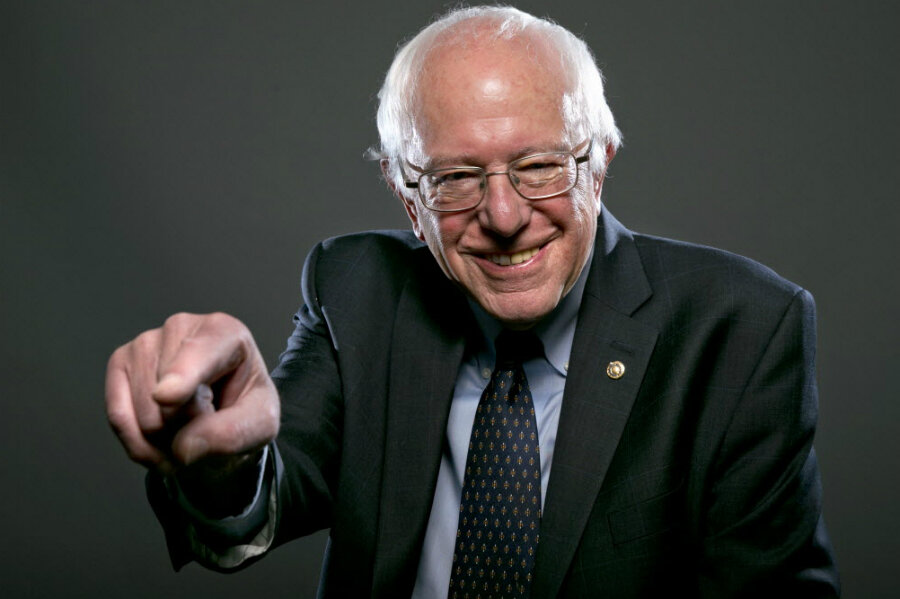Bernie Sanders 2016: Can he raise a liberal army?
Loading...
| WASHINGTON
Self-described “democratic socialist” Bernie Sanders kicks off his campaign for president on Tuesday in his hometown of Burlington, Vt. He’s hoping to attract an army of left-leaning Democrats who aren’t happy about Hillary Clinton’s past coziness with Wall Street and her Senate vote to authorize the Iraq War.
“I know what I believe,” said Senator Sanders in a fundraising e-mail issued prior to the event. “That’s why today marks the beginning of our political revolution.”
But how many voters share his beliefs and might be receptive to his message of income redistribution, expanded social benefits, and government-sponsored jobs and infrastructure efforts? How many liberals are there in America, and is their number on the increase?
First, a caveat: “liberal” has long been a loaded word in US political discourse. Decades of Republican campaign ads have denigrated liberals as profligate spenders, and perhaps soft on crime. Thus polls about what voters call themselves might not be, ideologically speaking, completely accurate.
That said, about 24 percent of American adults identify as liberal, according to a January Gallup survey. That figure has been on a slow rise since 1992, when 17 percent used the word to describe their political beliefs.
By this measure, liberals are a much smaller force than conservatives, which are the largest self-reported group in the Gallup poll, at 38 percent. But the liberals are gaining – the gap here is the smallest since Gallup began the ideology survey 22 years ago.
(By the way, self-described “moderates” are in the middle, at 34 percent. Perhaps that’s fitting.)
So the bottom line here is that if Sanders commands an ideologically leftish army, it might be smaller than a conservative corps led by, say, GOP Sen. Ted Cruz of Texas. Right?
Well, maybe. Maybe not. One of the confounding things about voters is that they’re not always consistent. They can say they’re liberal, and then oppose policies promoted by liberals. Or vice versa. The name is one thing, the beliefs sometimes another, as we noted above.
So last year the pollsters at Pew Research drew up a list of political values without the label “liberal” or “conservative” overtly attached. They asked such questions as whether government is inherently wasteful, or more efficient than it gets credit for. Their conclusion: 34 percent of voters consistently or mostly supported values which were inherently liberal. The corresponding number for conservative values was 27 percent.
Liberals, by this measure, look relatively stronger.
Pew’s conclusion, however, looked at things a bit differently. Both sides are getting stronger, they said. The percentage of voters who support generally liberal values is increasing – and so is the percentage which supports mostly conservative values. It’s the moderates that are getting weaker, as the nation polarizes around competing points of view.
And this increasing uniformity has been much more pronounced among the most politically active voters, according to Pew.
“Today, almost four-in-ten (38%) politically engaged Democrats are consistent liberals, up from just 8% in 1994,” wrote Pew Research in 2014.
Aha! Here’s where Sanders hopes to get the troops to fill out his “political revolution." It’s debatable whether liberals are a strong force in US politics writ large. It’s much more likely that they’re increasingly powerful within the Democratic Party itself – and after all, it’s the Democratic nomination that Sanders is running for.
In 2000, when George W. Bush won the presidency, only 29 percent of Democrats were self-described liberals, according to Gallup. Today the comparable number is 44 percent, edging close to half of all Democratic voters. That could be a formidable base for a champion of progressive causes.
Could be but isn’t, at least not right now. The real bottom line is that Democratic liberals are just as attracted to Hillary Clinton as other party factions. That’s why she’s ahead in polls of 2016 Democratic contenders by a gazillion points. She’s moved left on immigration and same-sex marriage, and she’s making inequality a central focus of her rhetoric, so far. Bernie Sanders wants to run to her left. But she’s seen where the party is and she appears determined to not allow herself to be outflanked by a liberal.






